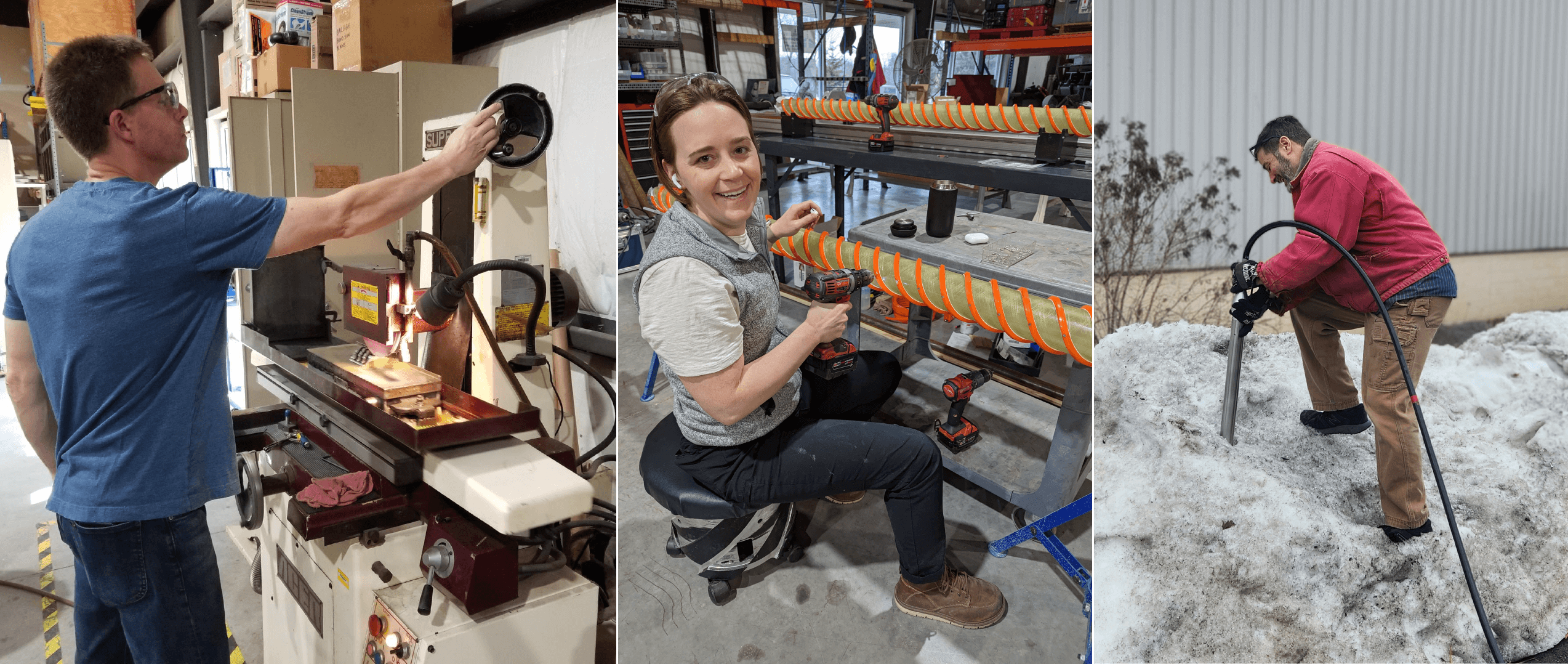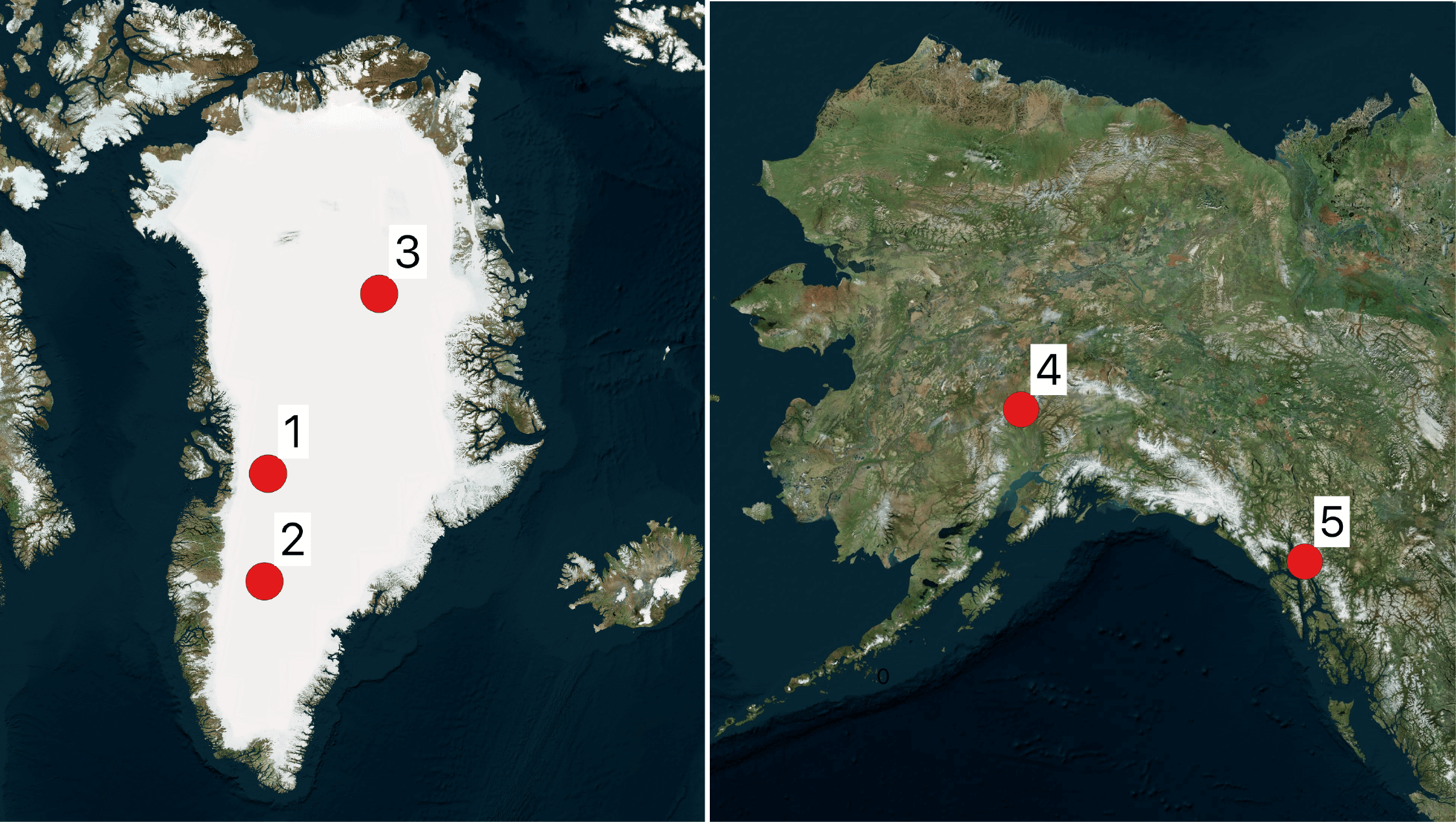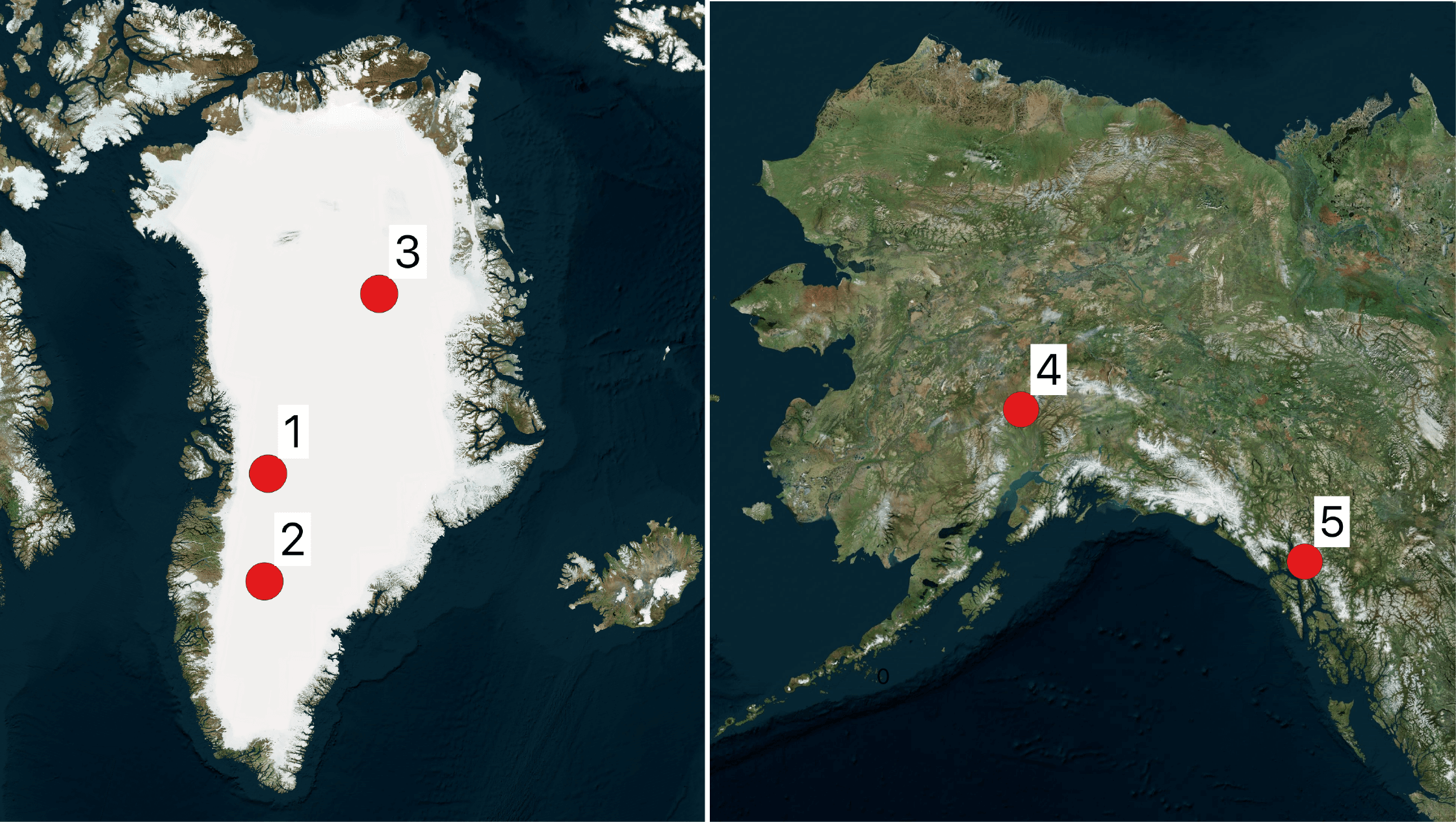IDP engineers worked efficiently during the second quarter to repair and test equipment returned from Antarctic field projects before quickly shipping the equipment to Scotia, NY, for projects in Greenland.
Hand Auger
Drill Maintenance and Testing in Full Swing at IDP-WI
Beneficial Drill System Testing and Operator Training Conducted near Madison, WI
With the COVID-19 pandemic having postponed all IDP-supported 2020/21 Antarctic fieldwork, IDP-WI took the opportunity to test several drills and new components in a prototype ice well at the UW Physical Sciences Lab in Stoughton, WI. A new Winkie Drill ice bit performed well under both very cold and warm ambient temperatures, and a new fluid chiller was also successfully tested. A new barrel set for the Foro 400 Drill was successfully tested, following issues witnessed during the system’s first use during the 2018/19 field season at Law Dome, Antarctica. Both an IDP and a Kovacs Sidewinder were tested, as IDP seeks to improve the Sidewinder design. The testing also provided an extremely beneficial and rare opportunity to train additional operators on the use of the equipment while drilling actual ice, as logistics limitations for field projects usually only allow for one driller.
Field Support to Northern Hemisphere Winter/Spring 2019-2020 Projects
IDP is providing support to the following Northern Hemisphere projects during the 2019-2020 winter/spring field season:
(1) The SG: The Ecosystem Ecology of Lake Ice Loss in North-Temperate Lakes project (PI Dugan; NSF award 1856224) advances the growing field of winter limnology by using long-term data collected on northern lakes in Wisconsin in conjunction with a snow-removal experiment to look at under-ice algae and the implications for ice-loss on spring algae blooms. Using an IDDO hand auger, the researchers will collect lake ice cores through an ice thickness of up to one meter to study the biogeochemistry and habitat of lake ice.
(2) The Collaborative Research: Sediment Transport Mechanisms and Geomorphic Processes Associated with Shore Ice along Cold Climate Coastlines project (PIs Zoet and Theuerkauf; NSF award 1916179 and 1950101) will test the hypothesis that limited or variable shore ice cover, when compared to consistent shore ice cover, results in enhanced storm-induced coastal erosion and damage to coastal infrastructure. Cold climate coastlines are highly vulnerable to reduced winter ice cover in response to climate change. The dynamics of how reduced ice cover influences coastal evolution is poorly understood which inhibits accurate forecasting of future coastal response in cold climates. Researchers on this project hope to improve our understanding of how sediment interacts with shore ice as well as the resulting coastal landscape change. The first part of the project involves laboratory experiments aimed at studying the physics of sediment and ice interactions. The second part of the project will gather field measurements that use the laboratory measurements as a basis to investigate how cold climate coastlines naturally respond to the shore ice. Using a SIPRE Hand Auger, the researchers will collect ice core samples of 1-3 meters in length on Lake Michigan and Lake Superior to inspect debris entrained within the ice for comparison with the laboratory experiments. This research will result in a model that will help explain how reduced and variable winter shore ice cover alters the coastal landscape, which will help coastal managers proactively plan for future climate change impacts.
2019 Arctic Field Season Support Completed
IDP successfully supported five projects during the 2019 Arctic field season.
(1) The Collaborative Research: Quantifying Heat/Mass Structure and Fluxes Through the Full Thickness of Greenland’s Percolation Zone project (PIs Harper and Humphrey; NSF awards 1717241 and 1717939) collected shallow firn cores in western Greenland using an IDDO hand auger and Sidewinder kit. The shallow cores were used to quantify firn density and provided access for temperature logging of the shallow firn thickness. The goal of the multiyear project is to use a combination of shallow and deep cores/boreholes to quantify the structure, thermal state, and heat fluxes through the full thickness of the firn column across a transect spanning western Greenland’s percolation zone. The researchers are using their own hot water drill to drill the deep (up to 100 meters) boreholes.
(2) The Collaborative Research: Refreezing in the Firn of the Greenland Ice Sheet: Spatiotemporal Variability and Implications for Ice Sheet Mass Balance project (PIs Rennermalm, Tedesco, and Hock; NSF awards 1604058, 1603331, 1603815) used an IDDO hand auger and Sidewinder kit for a third season in Greenland. During the multiyear project, the researchers collected several shallow firn cores from the southwestern sector of the Greenland Ice Sheet to investigate the stratigraphy, density, temperature, and liquid water content of the firn cover and its spatial and temporal variations.
(3) The Partnerships for Polar Science Education and Outreach in Greenland (JSEP) and Antarctica (JASE) project (PI Virginia; NSF award 1748137) encompasses two NSF-sponsored polar-focused programs – the Joint Science Education Project (JSEP) and the Joint Antarctic School Expedition (JASE) – that provide significant opportunities for training the next generation of STEM professionals and for polar-science outreach. JSEP, a project of the Joint Committee, was initiated in 2007 to educate students and teachers from Greenland, Denmark, and the U.S. The program brings US students together with Danish and Greenlandic students in Greenland where the group spends three weeks studying the causes and consequences of Arctic environmental change. As part of the JSEP program, an IDDO hand auger was used to expose the students to firn science (observing stratigraphic, density, and temperature changes with depth) at EastGRIP. JASE, a project in collaboration with the Chilean Antarctic Institute (INACH), takes U.S. students to Antarctica to work alongside Chilean students and examine Antarctica’s rapidly changing ecosystems.
(4) The EAGER: Exploration of the Denali Basal Ice Core Archive project (PI Kreutz; NSF award 1806422) returned to their 2013 ice core drill site and used the Stampfli Drill to collect a 50-meter long core from the summit plateau of Mount Hunter, Alaska. The researchers used a solar power system to power the Stampfli Drill during collection of the first ~45 meters of core when the sun was shining; the last 5 meters were collected during cloudy conditions, which required use of a generator to power the drill. The objective of the research is to understand the recent and past changes in summer temperature, snow accumulation, atmospheric circulation, and pollution in the context of the last 2000 years of natural variability in the North Pacific. In 2013 the researchers collected twin 208-meter long ice cores to bedrock from the same location (see Ice Bits 2013 Summer). This season’s 50-meter long core will be used to update the climate record from 2013 to 2019 and help aid in the interpretation of the deeper ice.
(5) The Electrothermal Drill Testing with the Juneau Icefield Research Program project (Ice Drilling Program) successfully field tested new modifications to the Thermal Drill. In late July and early August 2019, IDP Mechanical Engineer Grant Boeckmann, IDP Field Support Manager Anna de Vitry, and IDP contractor and Warehouse Manager Jim Koehler traveled to Juneau, AK, for a beneficial testing opportunity with the Juneau Icefield Research Program (JIRP). Utilizing the well-established logistics of the JIRP program, the IDP team was able to test new Thermal Drill modifications including a new 300-meter drill cable, a prototype ethanol delivery mechanism, and new heat rings. The IDP team successfully reached 294 meters and was able to refine operating procedures for the equipment.
Field Support to 2019 Arctic Projects
The second quarter saw the start of the 2019 Arctic field season. IDP is providing support to the following projects:
(1) The Quantifying Heat/Mass Structure and Fluxes through the Full Thickness of Greenland's Percolation Zone project (PI Harper; NSF award #1717241) will collect several shallow firn cores in western Greenland using a hand auger and Sidewinder kit. The cores will be used to quantify firn density, and the resultant boreholes will provide access for temperature logging of the firn column. The goal of the multiyear project is to use a combination of shallow and deep cores/boreholes to quantify the structure, thermal state, and heat fluxes through the full thickness of the firn column across a transect spanning western Greenland's percolation zone. The researchers are using their own hot water drill to drill the deep boreholes.
(2) The Refreezing in the Firn of the Greenland Ice Sheet 2019 project (PI Rennermalm; NSF award #1604058) will use a hand auger and Sidewinder kit to collect several shallow firn cores from the southwestern sector of the Greenland Ice Sheet to investigate the stratigraphy, density, temperature, and liquid water content of the firn cover. The project's goal is to better understand how the surface meltwater generated in the summer makes its way from its location on the ice sheet to the ocean. Two competing but not mutually exclusive theories are 1) the meltwater percolates into the ice sheet pores and is stored for a relatively long time. 2) The initial infiltrating meltwater refreezes at shallow depth in the firn, forming a hard pan that prohibits further infiltration. The project will test these two hypotheses through a combination of fieldwork, remote sensing from satellites, and modeling.
(3) The Partnerships for Polar Science Education and Outreach in Greenland (JSEP) project (PI Virginia; NSF award #1748137) is a multicultural polar science outreach program for high school students from Greenland, Denmark, and the USA. The program brings US students together with Danish and Greenlandic students in Greenland, where the group will spend several weeks studying the causes and consequences of Arctic environmental change. As part of the program, a hand auger will be used to expose the students to firn science (observing stratigraphic, density, and temperature changes with depth) at EastGRIP.
(4) The EAGER: Exploration of the Denali Basal Ice Core Archive project (PI Kreutz; NSF award #1806422) will return to their 2013 ice core drill site and use the Stampfli Drill to collect a 30- to 50-meter long core. The researcher's objective is to understand the recent and past changes in summer temperature, snow accumulation, atmospheric circulation, and pollution in the context of the last 2000 years of natural variability in the North Pacific. In 2013 the researchers collected twin 208-meter long ice cores to bedrock from the summit plateau of Mt. Hunter in Denali National Park. This season's 30- to 50-meter long core will be used to update the climate record from 2013 to 2019 and help aid in the interpretation of the deeper ice.
(5) The Thermal Drill Testing with the Juneau Icefield Research Program (JIRP) project is an internal IDP project. The Electrothermal drill, aka the "Thermal drill", is a mechanical ice coring drill based on the agile 4-Inch drill but with the addition of an electrically heated ring that enables coring in temperate ice that is close to the pressure melting point. Following planned system upgrades in PY 2018, including a new 300-meter long cable, new heat rings and an ethanol delivery mechanism, IDP is conducting a three-week test of the Electrothermal Drill system in Alaska in conjunction with other JIRP activities and established logistics. Following the test, IDP will inspect and repair the Electrothermal Drill equipment and make any necessary modifications.
Equipment Updates (2018 Summer)
Foro 3000 Drill
IDDO continued initial development tasks for the Foro 3000 Drill system during the third quarter. Detailed design of the winch drum and level wind are in process. Sizing calculations were made and a design initiated for the chip melter system. Sonde assembly drawings were largely completed. Design work is expected to ramp up in the fourth quarter in preparation for a Detailed Design Review in late September.
Foro Drill
Anti-torque section assembly was largely completed and motor section assembly was initiated on the Foro Drill. Cabling was completed for the control box and drill motors were ordered. Shipping cases were received for the sonde, tower, and winch. Cutter head assemblies, spare cable terminations, and anti-torque slip rings were also received. Some assembly and testing have been delayed in light of work on higher priority projects, but procurements are largely complete.
Rapid Air Movement (RAM) Drill
Continued acceleration of RAM Drill design, procurement, and in-house testing. The system was prepared, packed and shipped to Scotia, NY in late June. In early July, IDDO received an Expedition Permit from the Government of Greenland, and a two-week field test was subsequently completed at Camp Raven in late July.
Intermediate Depth Drill
Models and drawings were completed for the winch cable terminations and spare cable termination kits were received for the Intermediate Depth Drill. System maintenance continues at a slow pace, as does the testing and troubleshooting of the Mage Controls components. The components, returned to Mage Controls at the end of the second quarter, are expected back at IDDO early in the fourth quarter.
Winkie Drill
Borehole casing was specified and purchased in preparation for the Winkie Drill's first use in West Antarctica at a drill site with overlying firn. IDDO sought information from international colleagues regarding methods to seal the bottom of the casing to the ice. Packer components, benchtop testing for compressed air inflation, and detailed models of packer components were also researched.
Blue Ice Drill (BID)
Maintenance and upgrade tasks were largely completed during the quarter for the BID-1. The drill was subsequently cleaned, packed and shipped for the upcoming Law Dome project in Antarctica. IDDO continued communication with BID tent vendor Fabricon. Engineer Tanner Kuhl visited the vendor's location in mid-July to review the design and progress thus far, and the tent was completed in mid-August.
Thermal Drill
The Engineering Requirements document for the Thermal Drill was approved and released. IDDO engineers worked to identify, procure and test some thermal and power limiting materials and components during the quarter. New heat rings were specified, as the old model is now out of production, and a number of new rings were ordered late in the quarter.
Hand Augers
Planned modifications for the cleat and locking break components of the SideWinder units were implemented on all five kits in inventory. Equipment was returned from Svalbard and Greenland and was repaired as needed. Orders were subsequently placed for replacement of a few components that were stuck in the ice during the 2018 Arctic fieldwork.
4-Inch Drills
Maintenance was completed for the 4-Inch Drill system that returned from Antarctica. One core barrel set was modified to match beneficial modifications made to another barrel set in inventory. An improved cable keeper for the crown sheave was designed, fabricated and implemented.
Eclipse Drills
A more robust top cover and new side panels were installed on the Eclipse Drill traversing system. Beneficial updates were made to the Operator's Manual. Small tools such as strap wrenches and sharpening stones were purchased for use in the field.







